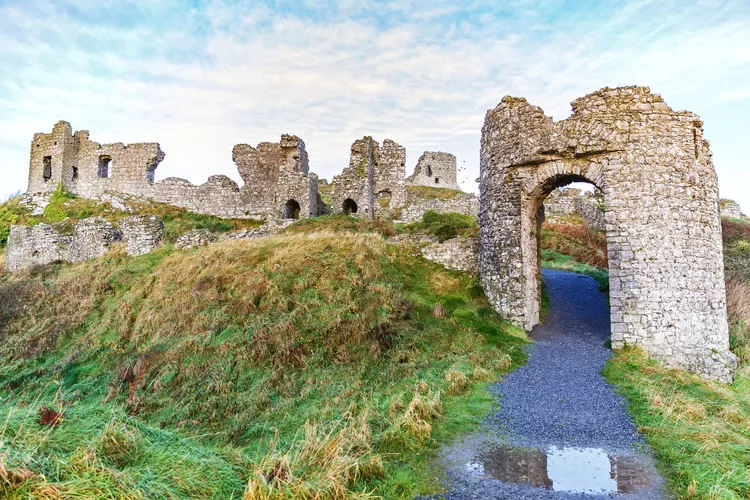Explore the Rock of Dunamase
History
The earliest record of the Rock of Dunamase dates back to the 2nd century AD when the site was included on a map by Ptolemy. However, there is no archaeological evidence that any buildings existed on the spot at that time.
The first dun, or fortress, was built in the 9th century and soon attacked and pillaged by the Vikings in 845. The next evidence of settlers on the same site does not come until over 300 years later when a castle was built on the rocky outcropping in the 1100s and used by the Normans.
It became one of the most important forts in Laois and was so strategic and desirable that Diarmuid Mac Murrough, King of Leinster, included it in his daughter Aiofe’s dowry when she was given in marriage to Strongbow. Strongbow later passed the castle at the Rock of Dunamase to his own son-in-law William Marshal, Earl of Pembroke.
Marshal added fortifications and lived at the Rock of Dunamase from 1208 to 1213. The castle stayed in the Marshal family for several generations before falling into the hands of the O’Moores and eventually being abandoned in the 1300s.
Already in disrepair, local legend says that the castle was destroyed by Cromwell’s forces during their conquest in 1651 to prevent it from being used as a stronghold. Sir John Parnell, an Anglo-Irish member of parliament, briefly attempted to restore the castle in the late 1700s, but it was ultimately left in its current crumbling state.
Architecture
While there are no historical records, it is commonly believed that the Rock of Dunamase was blown up by Cromwell’s forces in the 1600s. What remains are fragments of gray stone walls scattered atop a hill.
Most of the castle walls date back to the 12th and 13th centuries, though there are signs of an earlier ring fort as well. The Great Hall was located at the peak of the rocky outcropping, protected on three sides by cliffs. The ruins of the thickest fortified walls are at the lowest point, protecting what would have been the only entrance to Dunamase Castle.
While none of the walls are fully intact, some of the holes in the crumbling walls were intentional. The heavily defended castle was designed with “murder holes” through which archers could fire at approaching enemy forces. This design was state-of-the-art in the 13th century.
When Sir John Parnell attempted to restore the castle in 1795, he incorporated medieval architectural elements taken from other Irish castles. These can still be found mixed in with the original ruins.
Visiting the Rock of Dunamase
The Rock of Dunamase is a castle left in ruins, yet it is worth a visit when exploring Co. Laois. The site does not have a visitor center or an entrance fee, and the hilltop location provides stunning views of the surrounding countryside. Visitors can wander around the site freely without a guide, and an audio guide of the Rock of Dunamase is available from the Laois City Council website.
What Else to Do Nearby
One of the appealing aspects of the Rock of Dunamase is its scenic countryside location. However, this also means that there are not many attractions immediately adjacent to the old castle.
You can explore the Heywood Gardens, located about a 10-mile drive from the Rock of Dunamase, past Ballinakill on the Abbeyleix road. These 50 acres of gardens, forested land, and lakes feature trails for easy walking and a terrace that overlooks the Laois countryside.
Emo Court, an 18th-century country house built for the Earls of Portarlington, also boasts formal gardens and wooded areas that can be explored nearby.
For those willing to drive a little further, the Donaghmore Famine Museum, located about a 30-minute drive away, is an insightful stop. The museum is situated inside the Donaghmore Workhouse, established during the Great Famine (1845–1849) to provide shelter and meals to impoverished families. The workhouse housed approximately 10% of the local population, and the self-guided museum aims to tell the stories of the families who lived here during this challenging time.
The closest town to the Rock of Dunamase is Portlaoise, the county town of Laois, which offers traditional pubs, restaurants, and shops, allowing visitors to enjoy local culture and cuisine.





